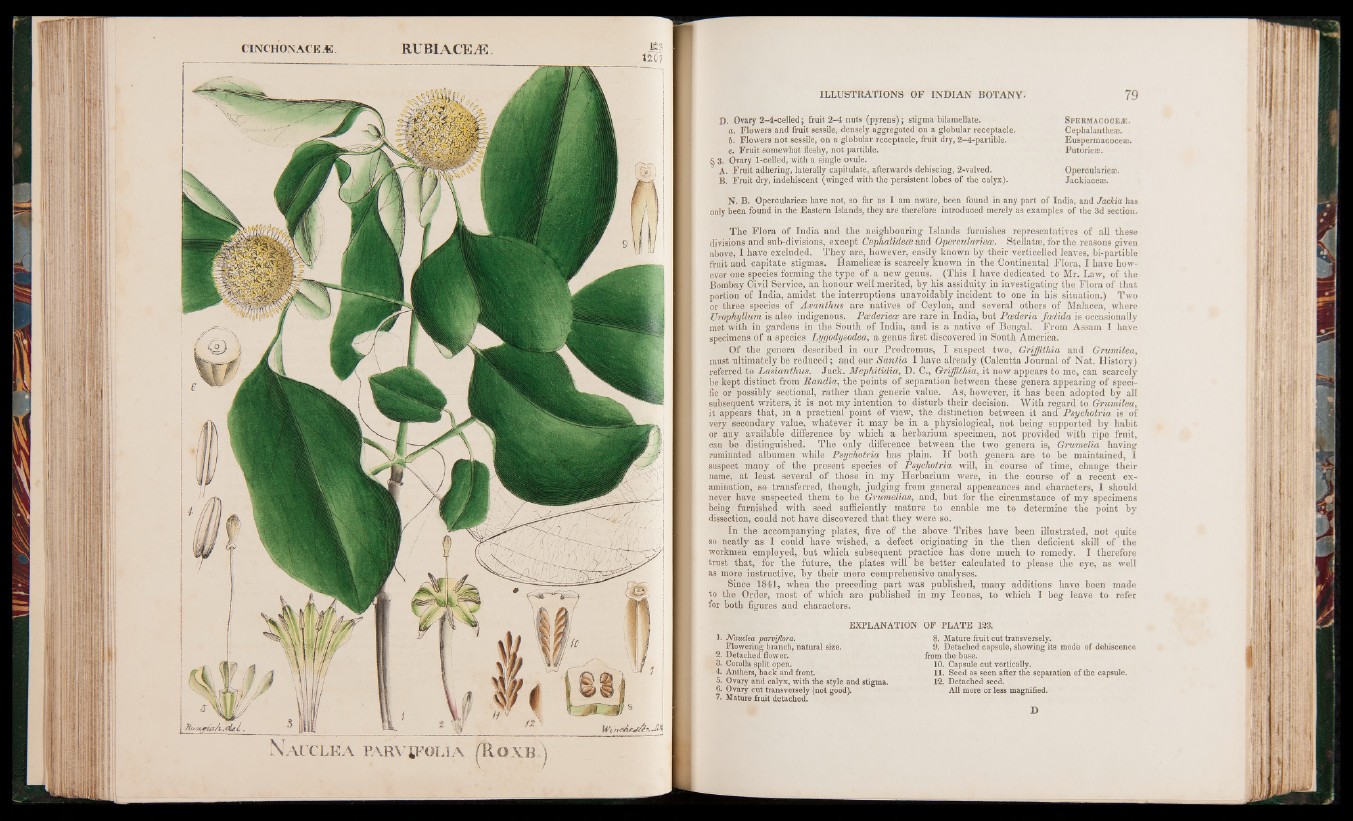
CINCHONACEÆ. RUBIACEÆ j e j
12C7
X a I CLEA PAR\ iFOLIA ( U o X B j
D. Ovary 2-4-celled; fruit 2-4 nuts (pyrens); stigma bilamellate.
a . Flowers and fruit sessile, densely aggregated on a globular receptacle.
b. Flowers not sessile, on a globular receptacle, fruit dry, 2-4-partible.
c. Fruit somewhat fleshy, not partible.
§ 3. Ovary 1-celled, with a single ovule.
A. Fruit adhering, laterally capitulate, afterwards dehiscing, 2-valved.
B. Fruit dry, indehiscent (winged with the persistent lobes of the calyx).
Spermacoceæ.
Cephalantheæ.
Euspermacoceæ.
Putorieæ.
Opère ularieæ.
Jackiaceæ.
N. B. Opercularieas have not, so far as I am aware, been found in any part of India, and J a c k ia has
only been found in the Eastern Islands, they are therefore introduced merely as examples of the 3d section.
The Flora of India and the neighbouring Islands furnishes representatives of all these
divisions and sub-divisions, except Cephalidece and Operculariece. Stellatse, for the reasons given
above, I have excluded. They are, however, easily known by their verticelled leaves, bi-partible
fruit and capitate stigmas. Hamelieae is scarcely known in the Continental Flora, I have however
one species forming the type of a new genus. (This I have dedicated to Mr. Law, of the
Bombay Civil Service, an houour well merited, by his assiduity in investigating the Flora of that
portion of India, amidst the interruptions unavoidably incident to one in his situation.) Two
or three species of Awanthus are natives of Ceylon, and several others of Malacca, where
Uraphyllum is also indigenous. Pcederiece are rare in India, but Poederia foetida is occasionally
met with in gardens in the South of India, and is a native of Bengal. From Assam I have
specimens of a species Lygodysodea, a genus first discovered in South America.
Of the genera described in our Prodromus, I suspect two, Griffithia and Grumilea,
must ultimately be reduced; and our Santia I have already (Calcutta Journal of Nat. History)
referred to Lasianthus. Jack. Mephitidia, D. C., Griffithia, it now appears to me, can scarcely
be kept distinct from Randia, the points of separation between these genera appearing of specific
or possibly sectional, rather than generic value. As, however, it has been adopted by all
subsequent writers, it is not my intention to disturb their decision. With regard to Grumilea,
it appears that, in a practical point of view, the distinction between it and Psychotria is of
very secondary value, whatever it may be in a physiological, not being supported by habit
or any available difference by which a herbarium specimen, not provided with ripe fruit,
can be distinguished. The only difference between the two genera is, Grumelia having
ruminated albumen while Psychotria has plain. If both genera are to be maintained, I
suspect many of the present species of Psychotria will, in course of time, change their
name, at least several of those in my Herbarium were, in the course of a recent examination,
so transferred, though, judging from general appearances and characters, I should
never have suspected them to be Grumelias, and, but for the circumstance of my specimens
being furnished with seed sufficiently mature to enable me to determine the point by
dissection, could not have discovered that they were so.
In the accompanying plates, five of the above Tribes have been illustrated, not quite
so neatly as I could have wished, a defect originating in the then deficient skill of the
workmen employed, but which subsequent practice has done much to remedy. I therefore
trust that, for the future, the plates will be better calculated to please the eye, as well
as more instructive, by their more comprehensive analyses.
Since 1841, when the preceding part was published, many additions have been made
to the Order, most of which are published in my leones, to which I beg leave to refer
for both figures and characters.
EXPLANATION
3. JVaudea parviflora.
Flowering branch, natural size.
2. Detached flower.
3. Corolla split open.
4. Anthers, back and front.
5. Ovary and calyx, with the style and stigma.
6. Ovary cut transversely (not good).
7. Mature fruit detached.
OF PLATE 123.
8. Mature fruit cut transversely.
9. Detached capsule, showing its mode of dehiscence
from the base.
10. Capsule cut vertically.
11. Seed as seen after the separation of the capsule.
12. Detached seed.
All more or less magnified.
D